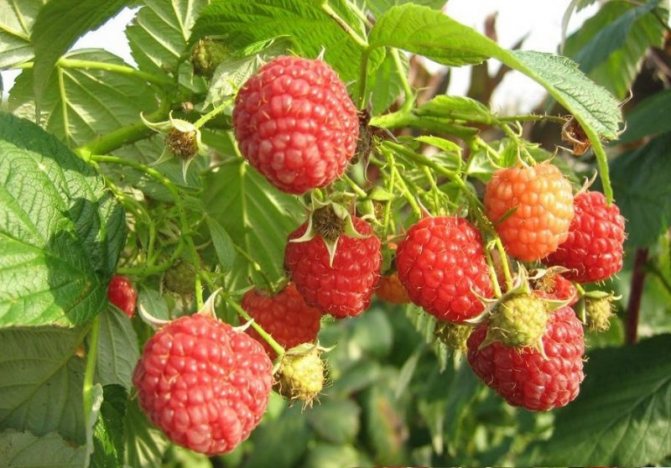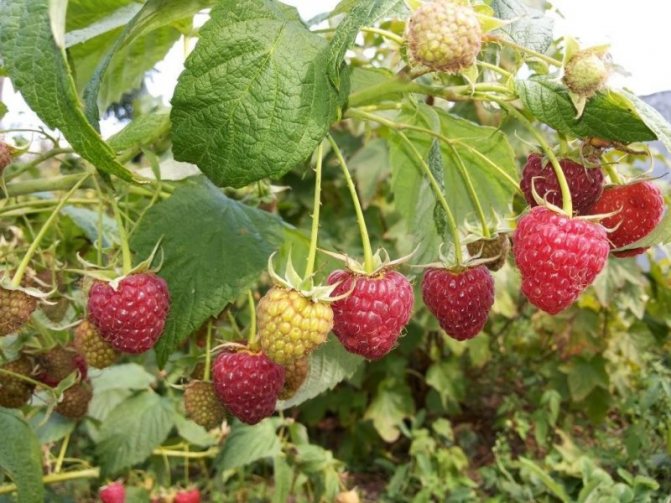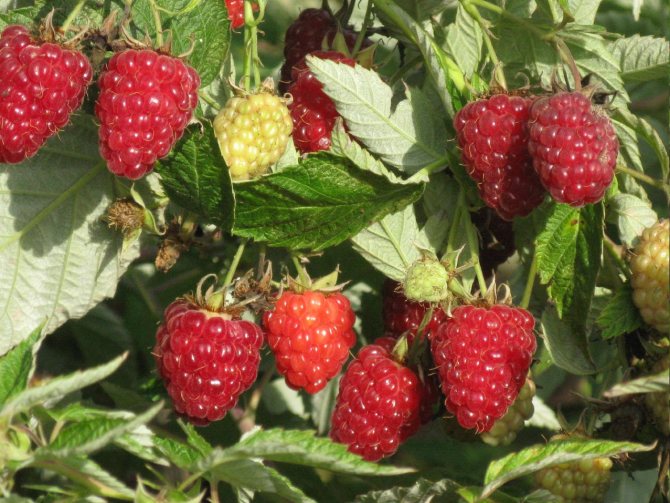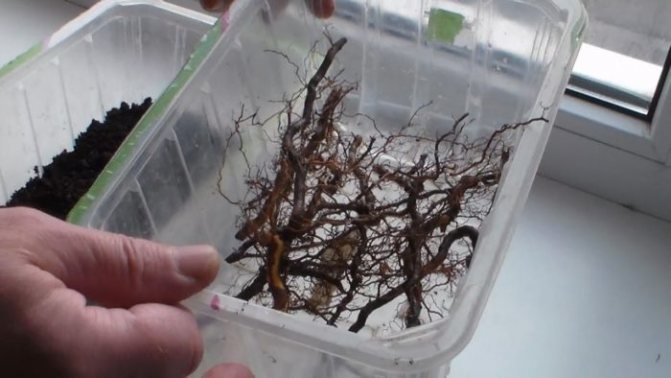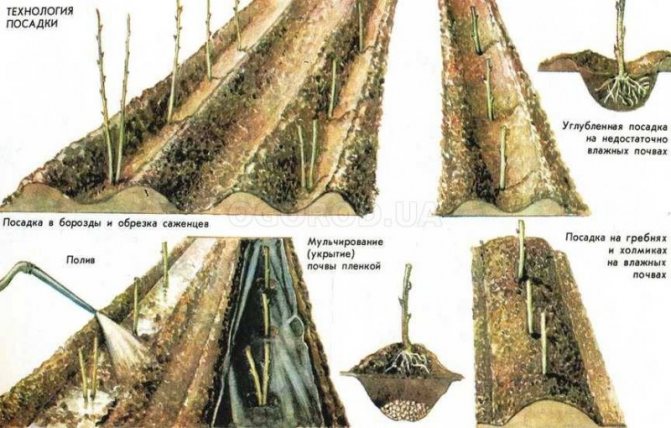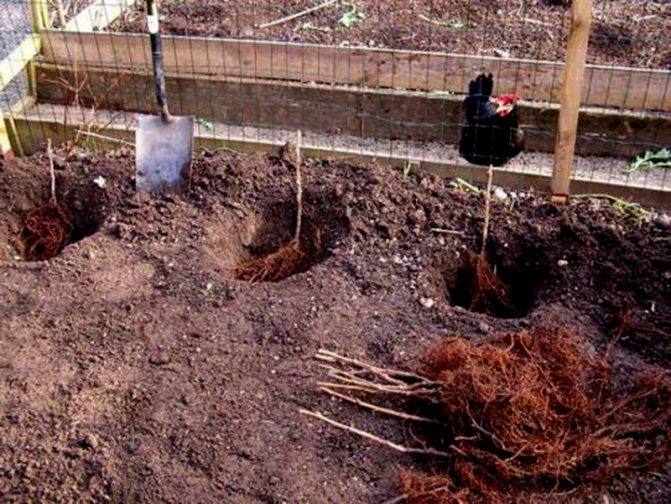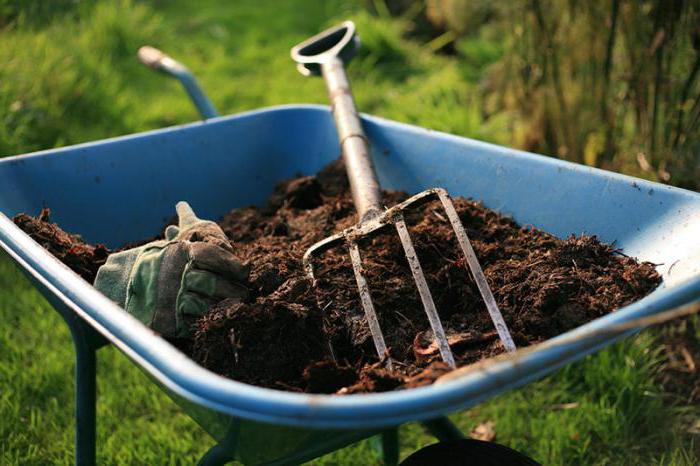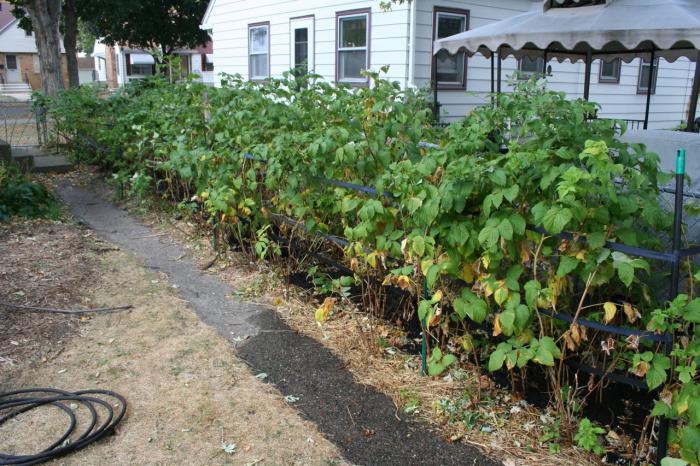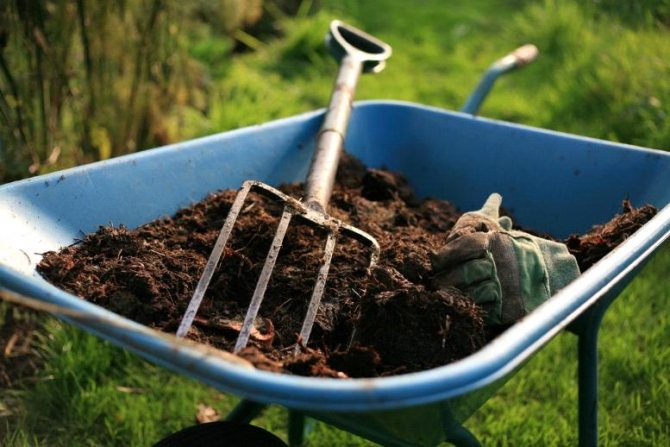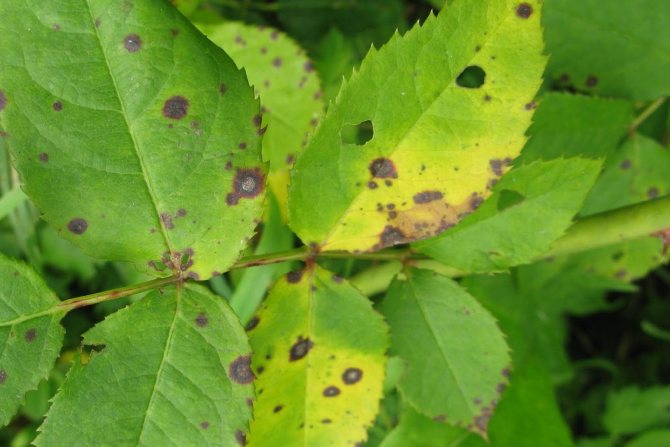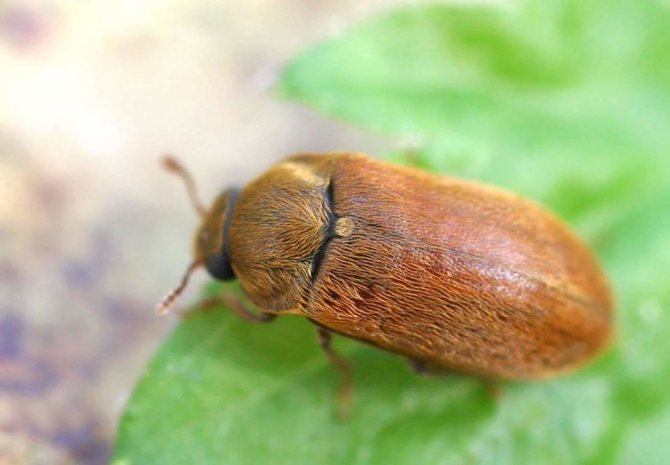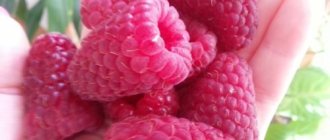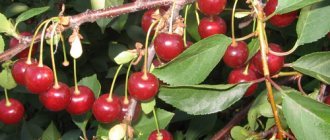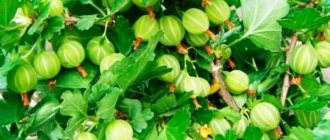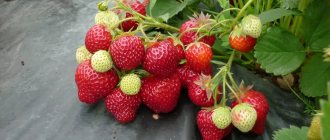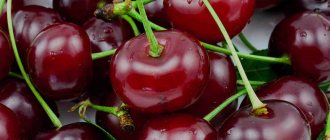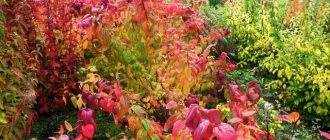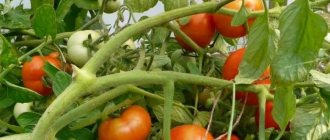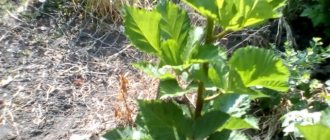There is no garden plot where there is not a single bush of everyone's favorite raspberry. Raspberry Taganka is a remontant variety that delights us with excellent quality berries, which are loved not only by children, but also by adults.
Taganka is an elite type of garden culture, characterized by large fruits, excellent taste and presentable appearance. This variety can grow in almost any region of our vast Motherland, due to its incredible resistance to climatic conditions and unpretentiousness to soils.
Photo of raspberry Taganka.
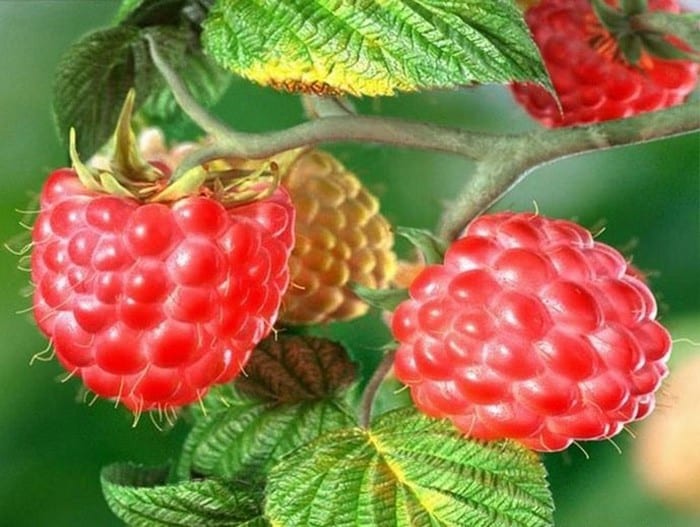
Description of the variety and its characteristics
The Taganka variety was born a long time ago, in 1976. It was created in the capital of our country, Moscow, by the outstanding scientist-breeder V. Kichina, who, when creating a hybrid, set out to obtain a type of garden berry that would be unpretentious to various weather conditions.
The breeder crossed a Scottish hybrid and a variety called Large Dvoroda, as a result of which the revered Taganka appeared.
Description of the plant
The bush is decorative and large in size:
- its growth reaches 2 m;
- numerous spreading branches and strong shoots are distinguished by a high growth rate;
- the color of last year's shoots is brown or brown-brown;
- the branches are covered with purple short but thin thorns;
- numerous leaves, large and beautiful, have a noticeable rich emerald color;
- small white flowers form panicle inflorescences, from which large berries are formed. On one branch, up to 30 large fruits can ripen at once. Often branches break off, not withstanding the severity of the harvest;
- flowering occurs in May and lasts the entire season - some flowers bloom, followed by others;
- raspberry Taganka is a variety pollinated by insects, therefore, when choosing a place for a raspberry tree, it is necessary to provide access to pollinating insects;
- the first wave of the harvest begins to ripen at the end of June. Fruiting lasts until early October;
- Bushes begin to bear fruit 2 years after planting of seedlings.
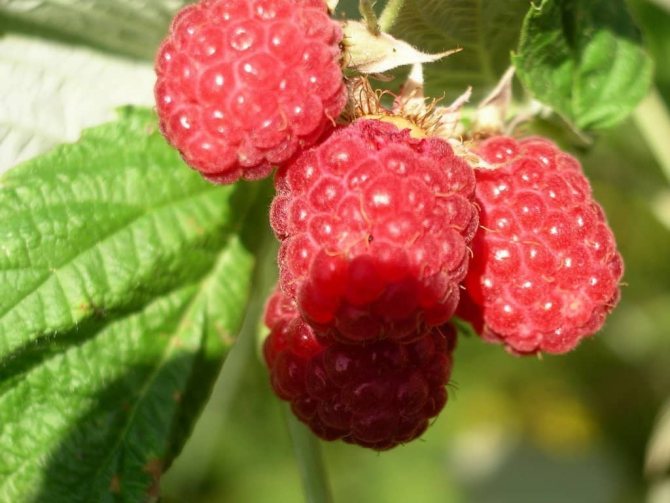

Description of berries
Taganka berries are simply gorgeous:
- they grow quite large - the weight of one berry can reach 20 g;
- fruit shape - round-conical;
- color - rich crimson with a remarkable gloss;
- juicy, aromatic pulp of a dark red color, covered with a dense, but thin skin;
- taste - harmonious, very sweet, without off-flavors.
The fruits of this variety are characterized by a high sugar content and a low acid content.
On a five-point scale, taste is rated at 4.5 points.


Using
Excellent aromatic jam and confiture are prepared from raspberries of this variety. It is dried, frozen, added to baked goods and fruit salads. Lovers of sweet alcoholic beverages make delicious liqueurs and liqueurs from Taganka berries. Both children and adults do not mind eating fresh berries.
Due to its rich chemical composition, this berry is used in alternative medicine.
Ripening and harvesting terms
This type of culture is remontant, that is, it bears fruit throughout the season, from late June to late autumn.The berries of the first harvest grow on two-year-old shoots, and the fruits that ripen closer to autumn appear on the shoots that have grown during the current season.
The crop is harvested as it ripens. If the berries are not picked in time, they will not crumble and will not lose their taste and appearance.


Yield
The variety has a high yield. From one bush for the entire growing season, 5 to 7 kg of juicy berries are harvested. With quality care, this figure can increase several times.
Storage times and transportability
Taganka berries can be stored in a cool place for about a week. Moreover, they will not be wrinkled and will not lose their presentation. The fruits tolerate transportation well. Because of this, the variety is popular with farmers who grow it for sale.
Positive and negative qualities of culture
The remontant raspberry Taganka has practically no flaws. It is hardy and has wide geographic boundaries. Its content does not require much effort and difficult conditions. She can withstand the scorching heat and frosts up to 30 grams.
The ovary of the remontant raspberry is resistant to short-term autumn frosts. After the temperature rises, the berries continue to ripen.
In the south, in the first half of summer, soil and air humidity is high, so it is difficult to achieve a crop of simple raspberries. And remontant, which ripens from early summer to late autumn, feels very good in the southern latitudes.
The berries are able to stay on the bush for a long time without decaying. This quality is very valuable for those who visit their garden plot only once a week.
The plant does not suffer from susceptibility to diseases and pests, which puts it on the same level as elite crops. And most importantly, this variety of raspberries is very fruitful. The yield from each bush reaches 4–5 kg.
Advantages and disadvantages of the variety - table
| Advantages | disadvantages |
| Drought tolerant | Somewhat inferior in taste to table varieties of raspberries |
| Frost resistant | With prolonged drought, the fruits lose their qualities. |
| Grows in any soil, in any geographic latitude | Refrigeration chambers required for transportation |
| Resistant to diseases and pests | |
| High keeping quality, transportable | |
| Has a high yield | |
| Fruiting for 4-5 months | |
| Soft thorns | |
| The fruits are large, sweet, fragrant |
Landing features
An important feature of the Taganka remontant raspberry is that, with normal care, it takes root in lands of different quality and mineral composition, although, like all plants, it prefers light fertile soils. In Central Russia, Taganka is best planted in late September or early October before the start of frost. Spring planting is also possible. But this should be done very early before the buds bloom on raspberries. Otherwise, the seedling may not take root.
Choosing a site for planting
Many remontant varieties require improved care, moist fertile soils. In comparison with them, the Taganka remontant raspberry is a real find for gardeners.
Nevertheless, despite its unpretentiousness, there are rules that a gardener should follow when choosing a planting site if he expects large and sweet fruits from his Taganka.
- Groundwater should run at a depth of at least 1.5 m.
- A site for planting should be chosen well-lit by the sun, from the south side.
- The plant should be protected from the wind by defining a place for it near a fence or wall of any building.
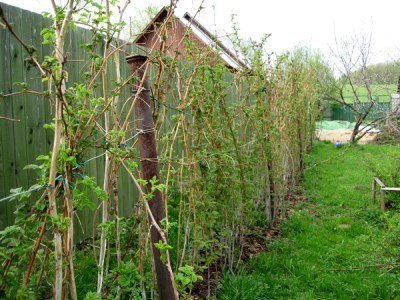

Raspberries are planted on the sunny side near the fence
Soil preparation for planting
Before planting, it is enough to dig up the site and loosen it thoroughly. Remontant raspberries should not be planted in acidic soil. First, the soil must be normalized with wood ash in the amount of 1 liter can per 1 sq. m. If necessary, you can fertilize the earth with compost (2 buckets per 1 sq. m). The humus is mixed with the ground.
Repaired raspberries cannot be planted in the soil where tomatoes, peppers, potatoes, eggplants were previously placed. If cereals and grains grew on the site, then this, on the contrary, is very good for raspberries.
Sapling selection
The best seedlings are found in nurseries. There they grow in garden pots and are guaranteed that their root system is not dried out. But if you ventured to purchase a seedling on the market, then first of all pay attention to the root. It should be fibrous, well developed. It is from the root that new shoots will grow every year. Also pay attention to the integrity of the seedling. Do not be afraid that the Taganka remontant raspberry sapling looks small and helpless. It will quickly grow and develop into a sturdy, luxurious bush. Amateur gardeners obtain seedlings by dividing a bush or growing cuttings.
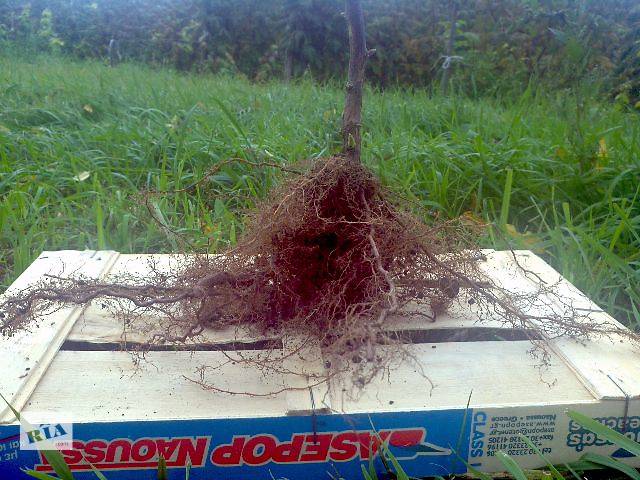

Seedling of remontant raspberry with a well-developed fibrous root
Step-by-step planting process
Saplings are placed at a distance of 50 cm from each other in a row. There should be 1.5 m between the rows. The planting process is very simple. Having decided on the site for the raspberry tree, you need to do the following.
- Dig a planting hole 50 cm wide and 60 cm deep in the soil dug up and fertilized with compost.
- Mix humus (peat, humus) with the ground and pour a small amount onto the bottom of the hole. Add 50 g of complex mineral fertilizer there.
- Sprinkle the root with the excavated soil.
- Pour a bucket of water or more under the root so that the water stagnates in the hole.
- Carefully lift the seedling so that the root collar is 5–6 cm above the surface.
- Pour the rest of the earth into the hole and press it tightly.
- Mulch the soil around the seedling with earth, green manure, peat, etc.
The bushes need to be planted every 6-8 years. The raspberry should be moved to a new place. The remaining area cannot be planted with raspberries again, since the previous plants sucked out useful substances from the soil, which are necessary specifically for raspberries, and in return left them harmful to young raspberry bushes.
Diseases and pests
Despite the fact that the variety has a high immunity to numerous ailments and pests, one should not forget about preventive treatment of plants - with poor care and adverse weather conditions, the risk of morbidity still exists. Plants can get sick:
- powdery mildew - a fungal disease, which is manifested by the appearance of a white coating on the leaves and fruits. At the same time, the berries deteriorate and become unfit for human consumption. To avoid this disease, the bushes are treated with colloidal sulfur before flowering and after harvesting. At the first symptoms, the plants are sprayed with a 1% solution of Bordeaux liquid (100 g of copper sulfate and 150 g of lime are taken for 10 liters of water). Processing is carried out 4 days in a row in the morning and in the evening;
- anthracnose, the causative agent of which is also a fungus. The disease begins with the appearance of small gray spots surrounded by a brown rim. Further, the leaves are rolled into tubes, and the fruits dry and fall off. The same 1% solution of Bordeaux liquid, as well as the drugs Nitrafen and Topaz, will help to fight this disease;
- root cancer. The disease is manifested by the appearance of growths on the root system. In diseased plants, leaves turn yellow and fall off, and the fruits do not have time to ripen. They fight the disease with an aqueous solution of copper sulfate (100 g of the substance are used per 10 liters of water).


There is a possibility of damage to the Taganka bushes by insect pests:
- raspberry aphids, which will help the drugs Nitrafen, Fitosporin, Karbofos or Fufanon. From folk remedies, an aqueous solution of wood ash with laundry soap is especially popular (for 10 liters of water - 1.5 kg of ash and 80 g of grated laundry soap);
- spider mite.To avoid this attack, the bushes are treated with colloidal sulfur 2 weeks before flowering (for 10 liters of water - 150 g of the substance);
- a raspberry beetle, which Karbofos or Fitosporin can drive away (for 10 liters of water - 4 ml of the drug).
Raspberry anthracnose.


Growing
The Taganka variety is grown almost according to the standard scheme, with the exception of a few moments. You need to know them in order to achieve good fruiting.
Bushes should be planted in well-lit places where there are no drafts and strong winds. An excellent solution would be a place near a shed or fence on the south side. Loose and soft soils with good air and water permeability are suitable for this variety.
Experts recommend planting seedlings in the fall (September - October). This will allow young plants to quickly take root and winter well.
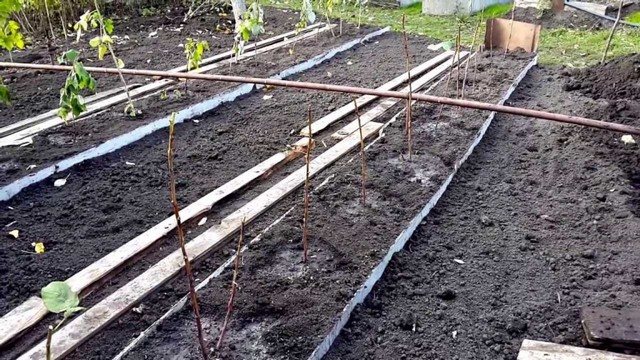

Before planting, the soil is prepared as follows:
- remove plant residues;
- digging and loosening;
- make organic feeding: peat, humus, wood ash.
It is better to plant Taganka in trenches. Their depth and width are 40–50 cm, and their length is arbitrary. A 1/3 dug trench is covered with soil mixed with fertilizers.
When planting, the distance between two adjacent bushes should be about 1 m, and between the rows - 2 m. Before planting, the roots of the seedlings are dipped in a clay mash, after which they are placed in a trench where the root system is straightened. After that, the trench is covered with soil and compacted.
Planting is completed by watering the planted bushes. Pour about 7-10 liters of water under each plant. After that, the land is mulched with humus / peat. The layer of mulch should be 5–7 cm. Then, to get abundant fruiting, you need to properly care for the raspberry tree.
Advantages and disadvantages
Raspberry Taganka has a number of undeniable advantages:
- decent harvests;
- good immunity to diseases and pests;
- excellent winter hardiness;
- high quality fruits (excellent taste, beautiful appearance, large size);
- ease of growing and care;
- the possibility of transportation over long distances;
- long fruiting.
Disadvantages of the variety:
- poor drought tolerance;
- the second wave of fruits does not have time to ripen in the northern regions.
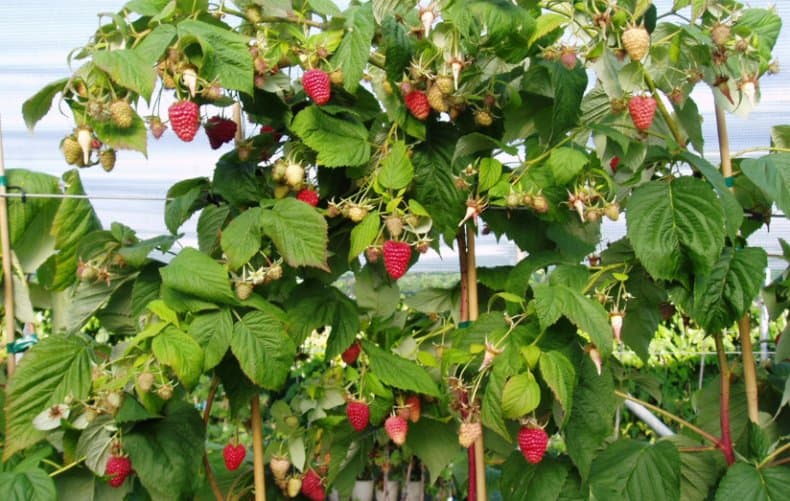

History of creation
This raspberry variety was bred in 1976 in Moscow. Scientists from the Breeding and Technological Institute of Horticulture and Nursery worked on the breeding process. Today there are rumors that the Taganka raspberry variety is one of the newest varieties of raspberries, but now you know that this is not entirely believable information. The hybrid was obtained by crossing the Largena Dvoroda variety and the Scottish hybrid form 707/75.
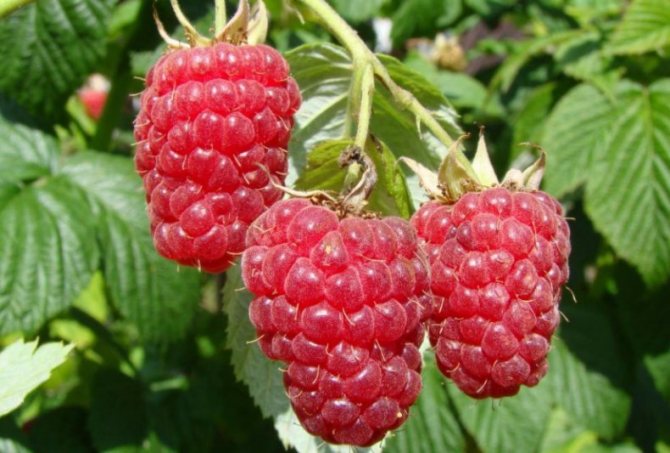

Landing
By following simple planting rules, you can achieve high yields:
- planting raspberries is recommended either in the spring, after warming the soil, or in the fall, long before the onset of frost;
- a place for a raspberry tree is chosen dry, well-lit and protected from the wind;
- groundwater should be no closer than 1.5 meters from the earth's surface;
- Taganka raspberries are undemanding to soils, however, you should still choose a site with fertile soil, or apply fertilizer before planting;
- a place for planting seedlings is prepared ahead of time - they dig up the soil, remove weeds and roots, add rotted cow dung, humus or bird droppings;
- plants are planted in grooves measuring 50 x 50. The distance between the seedlings is 1-1.5 m, and between the rows - at least 2 m;
- 1/3 of the groove is covered with a mixture of fertile soil with organic and mineral fertilizers (humus, potassium salt and superphosphate);
- a mound is made on this mixture. Saplings are placed on it, spreading the roots, and covered with earth;
- the soil is tamped and watered abundantly with water;
- the distance around the plants can be covered with humus or peat.
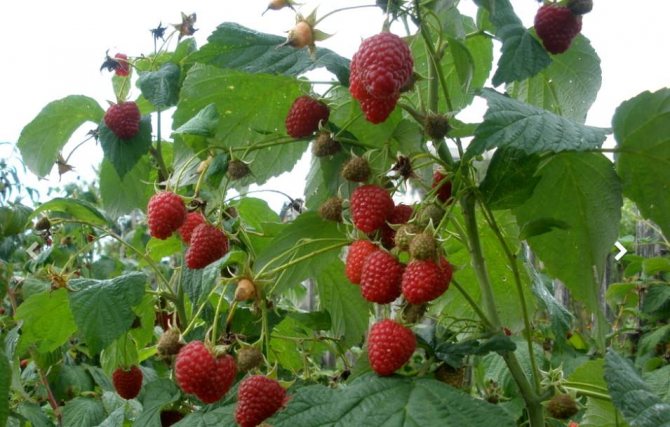

Choosing the right place
If you want to harvest a large amount of a large and fragrant crop every year, then you need to find the optimal place for planting this fabulous shrub.
All gardeners know that raspberries are a light-loving plant, and they need to be planted in a well-lit place. For planting, places under perennial trees or among tall shrubs are poorly suited. It is best to plant the Taganka variety on the southern or south-eastern side of the site, where the sun's rays will dominate most of the daylight hours.
This remontant variety of raspberries grows well on nutritious loamy soils. The area for planting seedlings should be protected from strong gusty winds. The groundwater level must lie at a depth of at least 1.5 meters. The acidity of the soil should fluctuate around 6-7.5 Rn. The increased humidity of the site and places where a large amount of water accumulates in spring are unsuitable for planting Taganka.


Care
Raspberry care consists in:
- watering, which is carried out 2 times a week. Taganka does not tolerate drought and waterlogging;
- dressing. Fertilizer is applied three times per season. In spring and autumn, organic matter is used, and in summer, during the flowering period, mineral complexes are used;
- weeding. The soil around the bushes is kept clean - weeds and organic debris are removed;
- loosening, necessary for the best oxygen access to the roots;
- pruning for the winter. After the plants bear fruit, they are completely cut off;
- if the bushes have been pruned, they need not be covered - there will be enough snow cover. If the pruning was not done, then the bushes must be wrapped with agrofibre.
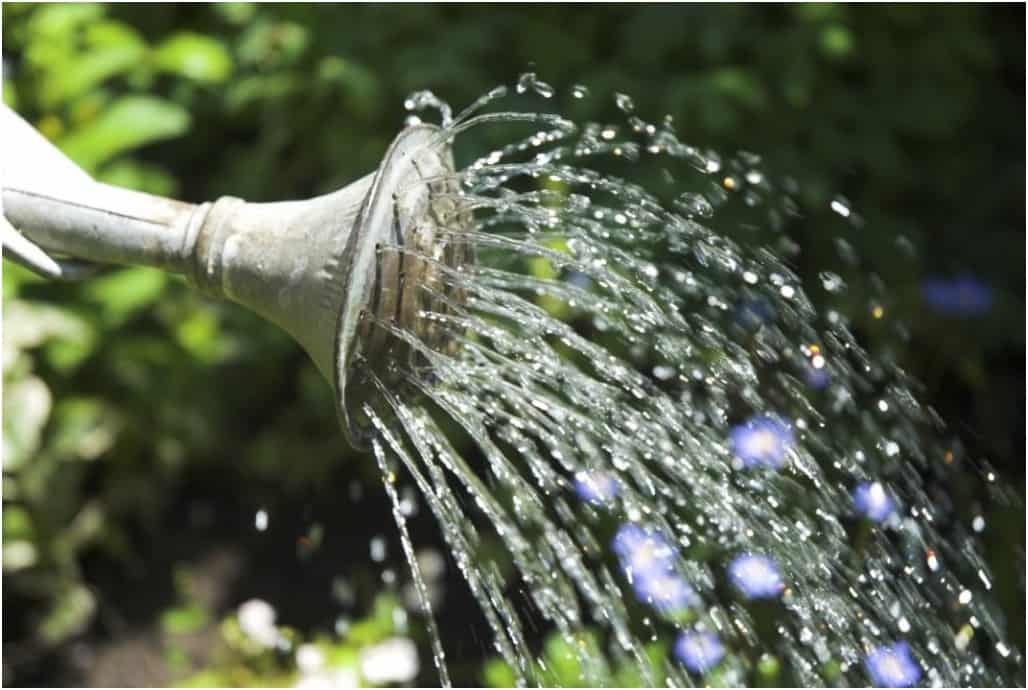

Further care of Taganka raspberries
The main thing when growing Taganka raspberries is timely watering and feeding, the yield of the variety and the taste of berries directly depend on their regular introduction.
Irrigation mode
This variety of raspberries is picky about soil moisture - with a prolonged lack of water, the berries become smaller, their taste deteriorates. Therefore, water must be applied regularly. The usual watering regime is 1 time in 12-14 days in the morning or in the evening. The Taganka raspberry has a special need for watering during the formation of ovaries and during the period of mass ripening of the crop.
Before the beginning of the budding period, it is better to ensure watering of raspberries by sprinkling, then moisture is introduced into special grooves, which are carried out along the beds with raspberries. For each square of the area, about 2-2.5 buckets of water should be brought.
Photo of watering raspberries
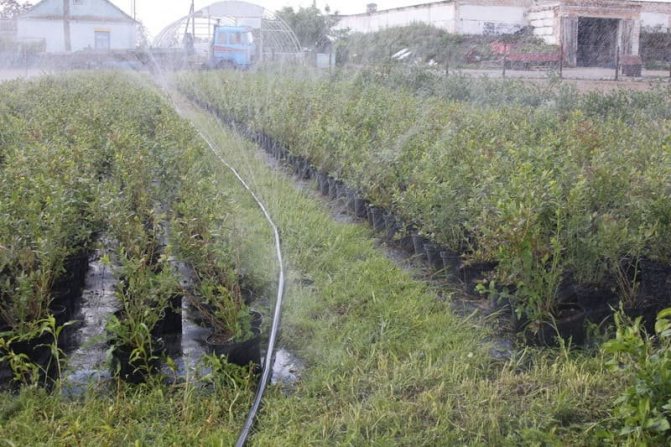

Raspberry garter
The shoots of this variety of raspberries are tied up so that they do not break under the weight of ripening berries or from gusts of wind. Usually, single trellises are used to tie up Taganka raspberry bushes. To do this, at the beginning and end of the row, pillars are placed, the height of which should be at least 2-2.5 m. A wire is pulled on them in 4-5 rows, to which the stems are tied in several places.


Top dressing
In the first season after planting Taganka raspberries, it should not be fed if all the necessary fertilizers were added to the soil when planting seedlings.
From the second year, fertilizers are applied to the raspberry plant according to the following scheme:
- in the spring, before the start of sap flow, fertilizers containing nitrogen are applied;
- in the first decade of June - organic matter (rotted manure or compost). At least 50 kg of such fertilizers are applied to each square of the area;
- in the autumn, any potassium salt should be added to the soil.
Every 3 seasons in the spring, superphosphate should be added to fertilizers - at least 60 g per square of area.
All organic fertilizers are applied before digging up the soil, and mineral fertilizers are scattered over the beds, then watering is performed.


Raspberry pruning Taganka
If this remontant raspberry is grown as an annual crop, then in the autumn after harvesting, all shoots are cut out at the root.When growing plants in a two-year mode in the autumn, only the shoots of the previous year are removed.
In the spring, only all dry or damaged stems should be removed. If the raspberry is heavily thickened, then it should be thinned out.
Raspberry Taganka gives a large number of suckers, so during the summer season it is necessary to remove excess root suckers.
Photo of the raspberry trimming scheme
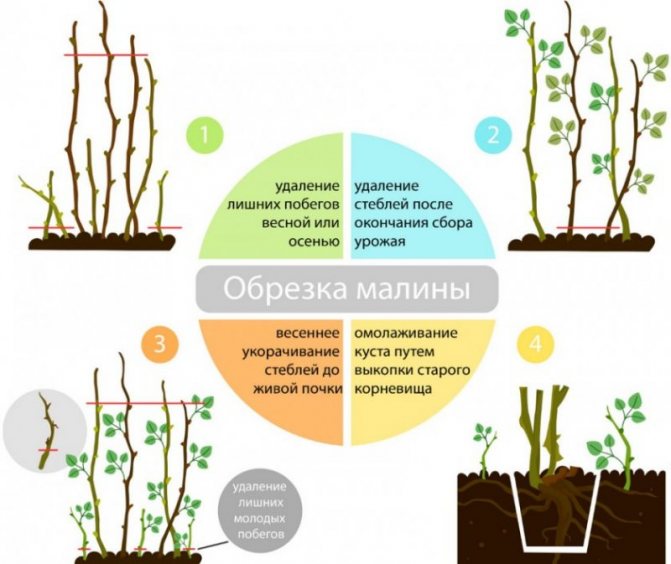

Preparing for winter
Before the onset of frost, Taganka raspberry bushes should be covered. First, the raspberry is pruned, all shoots are immediately burned. When completely cutting out the bushes before freezing, it is enough only to cover the beds with a layer of mulch 12-15 cm thick. Peat is used as a mulching element.
When growing raspberries in a two-year mode, the stems of the current year are tied, bent over to the soil and covered with spruce branches, straw or non-woven agrofibre.
Photo of a raspberry shelter for the winter
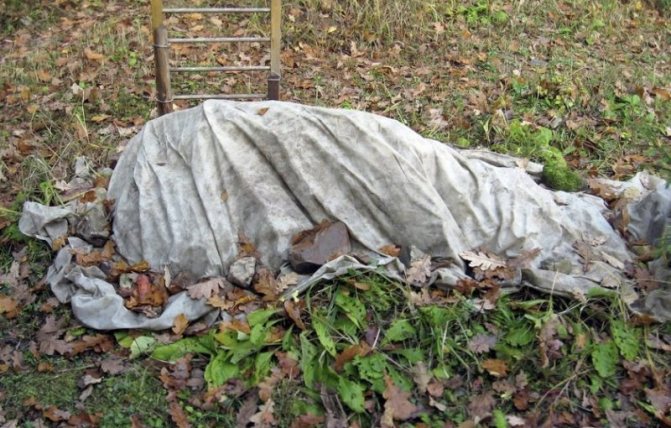

Gardeners reviews
The Taganka raspberry variety is old and proven. It is very popular with gardeners and does not require much advertising. Reviews about him are only positive.
Igor, 50 years old
»Taganka is the best of all remontant varieties. The plants are powerful and strong, the berries are large. The taste and presentation are excellent. On my site there were how many remontant varieties - removed. Left Taganka alone. "
Inna, 37 years old
“Taganka has been growing for me for a long time. The variety is just class! And how hardy! The berries are of excellent taste and are very beautiful. You can enjoy them until late autumn. Bushes are unpretentious. They winter well. "
Harvesting and storage


The ripening process of raspberries of the "Taganka" variety can take up to a month in favorable weather.
Taganka raspberries begin to ripen from the second half of August. The ripening process takes about four weeks. In a warm autumn, you can enjoy juicy taganka berries until the end of November.
The fruits perfectly retain their shape during transportation, and they can also be stored for several days in the refrigerator, while maintaining their taste.
According to most housewives, this variety of raspberries is ideal for preserving and preparing a variety of juices and fruit drinks.
Description
The bush of the plant is vigorous. The shoots are tall, quickly gaining in volume. They grow vertically. Taganka bushes often reach 2 meters in height.
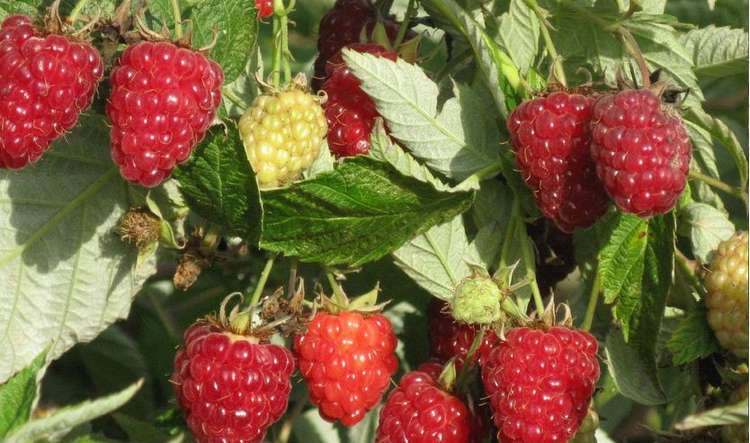

The main shoots of the bush are 6-8. They are elastic, thick. At a young age (when the bush is a year old), they have a light green color, they break easily. In a biennial plant, they turn brown and firm.
Each shoot forms many fruit branches. They, like the shoot itself, are highly durable and can withstand a bountiful harvest without any problems.
The leaves are collected in pairs of three. They are dark green in color. The greatest number of thorns is located on green shoots, which are quite fragile. Like the shoots themselves, the thorns are also not very hard. Have a faint purple color.
The variety is not picky, and even if you run its bush and stop caring for it, the berries will grow to a fairly decent size. On average, 7 gram fruits appear on a well-groomed plant. With industrial cultivation, using various growth accelerators, it is possible to obtain almost 20 gram berries. Some gardeners loudly call the Taganka fruits plums, as they are almost the same size as them.


The fruits of the plant are bright red in color. Oval shape. The shell of the fruit is dense, so there are no problems with crushing the product during harvest.
The berry is considered a dessert. The pulp has a pleasant smell and is very sweet. There are several bones inside.
Taganka belongs to remontant varieties. Because of this, it bears fruit up to 6 times per season. With all this, about 45 kg of product is collected from the bush. If this plant is grown for commercial purposes, then about 20 tons of marketable berries are obtained from 1 hectare.
Reproduction
Taganka reproduces very easily.Young shoots, which formed in the second year, can already be transplanted to a new place. It should be noted that, despite their unsightly appearance (thin and small stems), the seedlings of this variety grow quickly and have significant vitality.
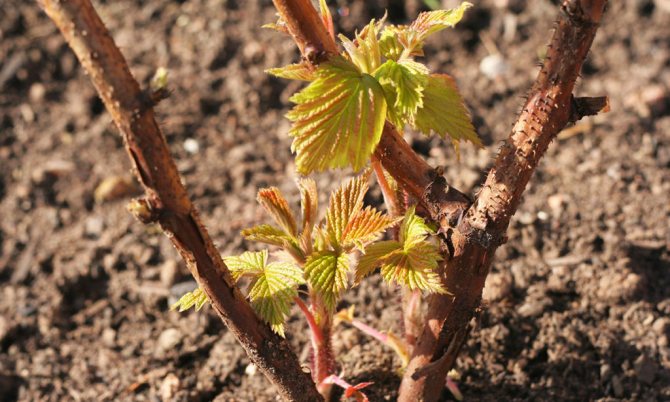

Raspberries of this variety are easy to clean. However, despite this, the raspberry tree needs constant watering, as well as a number of measures aimed at preventing diseases and parasites.
It should be noted that Taganka does not tolerate stagnant water. But its watering should be carried out often, especially during the formation of ovaries and fruits. Watering the bushes is carried out 2-3 times in 7 days. This procedure is performed in the morning or in the evening. Watering should be carried out by sprinkling or trenching. Three buckets of water should be poured under one bush.


All remontant varieties require pruning. After harvesting, the bush is cut to the ground, leaving only hemp. In this form, raspberries are sent for the winter. To make the plant better survive the winter, the hemp from above is mulched with snow, humus or leaves.
In the spring, sanitary pruning is carried out, which involves the removal of dry and damaged areas from the shoots. At this time, excess root shoots are also cut off. This will allow the main shoots to get all the nutrients they need for fruiting.
In the second year after planting the bushes, they are fed. It involves the introduction of humus into the soil, to which ammonium nitrate is added. Top dressing is made at the rate that 1 sq. m. should go to five buckets of fertilizers.


During the flowering period (in June), the raspberry tree is mulched with horse humus, which is mixed with peat and straw. Such a layer of mulch perfectly retains moisture in the ground.
You can extend the growing season of plants by introducing an infusion of cow or bird droppings into the soil. The infusion is prepared by stirring 1 shovel of fertilizer in 1 wind of water.
The actions described above are quite enough for the raspberry bushes to bear fruit well.

